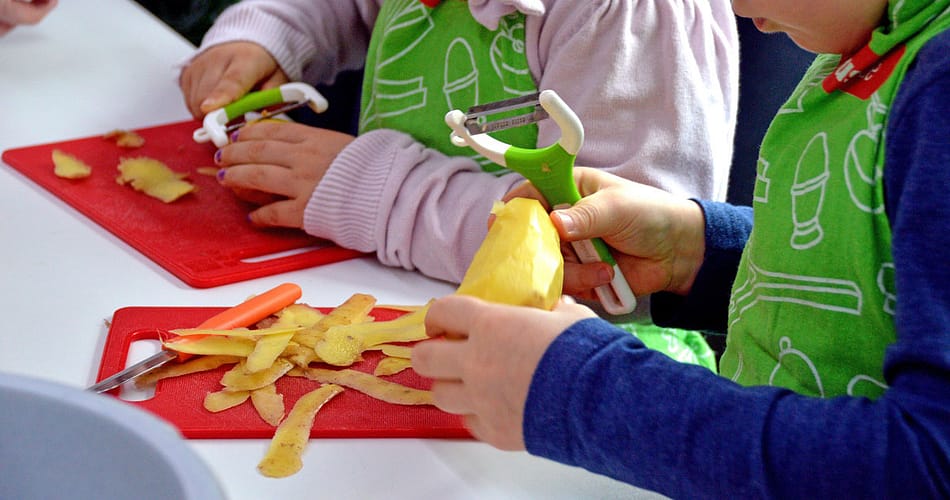When a child learns a new concept by doing, touching, exploring or experiencing something, rather than just being told about it—that child is creating pathways in the brain for further knowledge. For early childhood educators looking for ways to improve children’s learning—hands-on experiences are critical to success.
So, how can you maximize children’s learning through hands-on experiences? Here are a few suggestions:
Sensory play
Sensory play is the type of play that stimulates children’s senses. Most often, we think about teaching children through sight and sound. The other senses including touch, and even smell and taste, are also important. By using their senses to explore, children’s brains are engaged and making important connections.
- Infants and toddlers: Sensory bags provide a safer way to explore a variety of materials and textures. Here is a short video on how to make a sensory bag. Choose a heavy-duty zip bag, tape the bag to the floor or surface, and remember to keep close supervision when little ones are exploring to ensure their safety. That way you can respond quickly if the bag begins to leak or break.
- Preschoolers: For preschoolers who are no longer mouthing objects, you can experiment with a variety of different sensory activities, and rotate these experiences throughout the year.
- To engage children’s sense of smell, set up a scent activity, or add empty spice jars to the dramatic play center. Make sure the jars are completely empty, but wipe the jars clean with a paper towel only, so they retain their lovely scents.
- Family preferences: Food is often used as a sensory material but many families do not want their children to play with food, as this sends a confusing message to children about how food is used. Explore alternatives to using food in sensory tables. Here are a few ideas to get you started: sand, kinetic sand, organic potting soil, birdseed, small pom-poms, or Kidfetti. (Important Tip: Keep in mind the age and development of the children in your group when deciding what material to use. Young children that explore by mouthing objects should not have access to small items for sensory play.)
- Keep it sanitary: Limit the spread of germs, have children wash hands before and after shared sensory play. You can also provide sensory experiences individually. Instead of large sensory table, offer a smaller sensory bin for one child. Water or sensory material can be switched out and sensory tools sanitized in between children.
Real-world objects
High-tech tools like computers, tablets and smart boards can add to children’s learning, but they don’t replace the tactile experiences that children need to make sense of their world. Learn more tips on how to make the best use of technology in your setting. Focus on how you can introduce real objects that children can touch and feel. Children begin to understand abstract concepts once they have hands-on experiences to draw from. For example, children who have had experiences working with three dimensional shapes in the block center in preschool show stronger gains in math learning in preschool and beyond.
- Math concepts: Introduce a variety of three-dimensional shapes through block play. Name the shapes children are using, and encourage them to pay attention to the properties of the different shapes. Call attention to the weight, shape, density and size as children use the blocks.
- New vocabulary: Introduce new vocabulary using real objects children can explore. Children will remember new words better when they have real experiences with those items. Bring in items that connect to the topic or unit, such a real icicle, snow, mittens, gloves, scarf and earmuffs for a unit on winter weather, or seashells, sand dollars and seaweed for a unit on the ocean.
- Encourage exploration: Let them touch and discover. Fill your learning environment with items that children can safely explore on their own. Remove safety hazards so children are free to explore with their hands. Encourage children’s natural curiosity to collect objects like rocks, leaves and sticks during outdoor play, and build classroom collections of these objects.
Real work
Children develop important skills through experiences with real work. Helper jobs such as watering plants, feeding a pet, setting the table and taking attendance help preschoolers gain confidence and independence, and builds a classroom community among the children in your care. Even toddlers can help clean up toys, throw away their trash, put laundry in a hamper and put away blankets after nap.
- For toddlers, provide opportunities to help throughout the day as opportunities arise. For preschoolers, create a system of classroom jobs, using a jobs chart or visual display. Adapt as needed.
- Provide opportunities for real work, such as :
- Cleaning up: wiping up spills, sorting toys, washing tables with soapy water
- Preparing for events: putting out paints and smocks for an art activity, setting out cots for nap, carrying materials for outdoor play
- Leading routines: announcing the transition to a new activity, leading the morning welcome routine, counting the number of children present
- Cleaning up: wiping up spills, sorting toys, washing tables with soapy water
- Engage families by talking about how children learn through real work. NAEYC has a great resource on the benefits of big jobs for children at home.
At Quality First, we love to hear from you! How do you engage children with hands-on learning at your program? Share your ideas so others can be inspired. Send us an email at qualityfirst@firstthingsfirst.org.
References
Trawick-Smith, J., Swaminathan, S., Baton, B., Danieluk, C., Marsh, S., & Szarwacki, M. (2017). Block play and mathematics learning in preschool: The effects of building complexity, peer and teacher interactions in the block area, and replica play materials. Journal of Early Childhood Research, 15(4), 433–448. https://doi.org/10.1177/1476718X16664557
